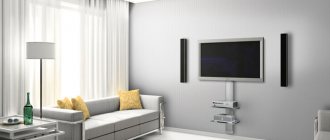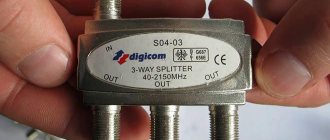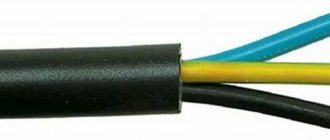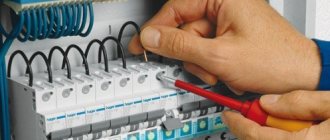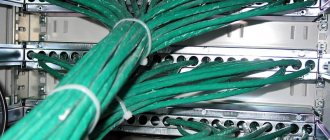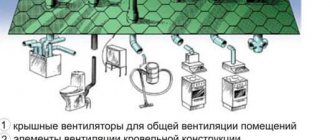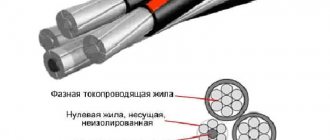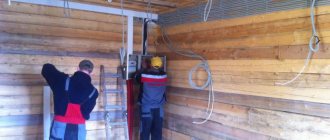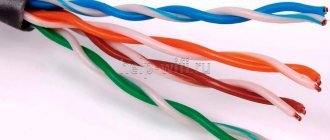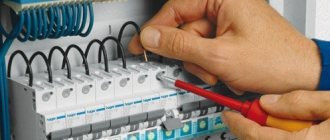With the advent of satellite and digital TV broadcasting, the question increasingly arises of which cable is best to choose for a TV - after all, the quality of the received signal depends on it. For example, when switching to satellite or digital broadcasting from analogue TV, the equipment is often not tuned to certain channels, the image may become fuzzy, blurry, and sometimes ripples and interference appear on the TV screen, although a completely different quality is expected from modern technologies. The main reason for the occurrence of such defects is the technical discrepancy of the old line in relation to the new signal characteristics. It is logical that for high-quality operation of television equipment you will have to change the cable.
Content:
- 1 Definition of electrical cable
- 2 Structure of the television conductor
- 3 Marking
- 4 What to look for when selecting a cable? 4.1 Protective layer material
- 4.2 Mechanical strength
- 4.3 Screen Features
- 4.4 Cable length and thickness
- 4.5 Outer shell
- 4.6 Central core
- 4.7 Manufacturer
- 4.8 Dielectric layer
When choosing a coaxial cable for a TV, you will notice that various types and brands of cable products are offered for sale to customers. Before purchasing coaxial wire, it is recommended that you familiarize yourself with the characteristics and differences between different product models, as well as the characteristics of its design.
The best antenna splitters for 2 TVs
PROconnect
The compact splitter functions as a signal divider coming from the main TV antenna. It has an input connector F, where the antenna cable is connected, and several outputs for connected devices. The connection diagram is clearly depicted on the device itself.
The bandwidth of the divider is 5-2500 MHz, which allows it to be used for satellite systems. Users note the reliability of the device and high-quality signal division.
pros:
Minuses:
REXANT
Chinese splitters make it possible to separate the main and secondary signals, or evenly distribute the flow over several routes.
The manufacturer offers two types of products: fiber optic and radio frequency. Compact models with coaxial leads belong to earlier versions, but have not lost their relevance. rexant couplers have a simple design. Different models can be combined with each other. The device will allow you to watch TV shows without interference while maintaining signal quality. pros
Minuses:
Source
Electrical cable definition
Coaxial (coaxial cable) is a telecommunications element that allows you to simultaneously broadcast a certain number of high-frequency signals with minimal losses. Its operation is based on the potential difference that appears in the presence of two different metal conductors, separated from each other by means of a guide insulating layer. Why is coaxial cable needed?
Insulated cores are used in devices that transmit industrial and satellite television signals in automatic and alarm systems or computer networks.
TV conductor structure
Getting acquainted with the structural properties of the cable for a TV, you will notice that all models provide for a similar systematization of the internal element:
- Coaxial is a conductor that affects signal transmission. It is made from copper tube, solid wire or stranded material. The quality of the raw materials influences the permissible bending coefficients and the signal.
- Dielectric is a plastic layer that acts as a conductor retainer.
- Metallized thickness is a combination of polyester with copper or aluminum.
- The metal braid is made of foil and thin wire. The more complete its weave, the better the quality of the cable and the degree of protection from external influences (radiation, moisture).
- The outer casing protects all structural components of the electrical wire.
The differences between the products lie mainly in the characteristics of the material used.
When solving the problem of which television cable is better to choose, you need to decide on your goals. For example, if the signal distance is minimal, it is not recommended to overpay for an expensive cable.
Features of cables for street video surveillance
Since we've touched on a small portion of what an outdoor cable should look like, we encourage you to continue learning more about the larger facts surrounding this topic.
In order to choose your cable, you need to decide on the place where you are going to install it. The following options are suitable:
- Laying wires on walls or along their surface. This is the standard installation method.
- By air on a supporting cable.
- Underground. Pipes and trenches are perfect.
In addition, do not forget that the cable acts as a power source, which means that it must charge the video cameras in a timely manner. Contact a specialist with outdoor measurements to help you decide on a cable that would be ideal for your area.
Cable length and protection
Each cable has a different length, since the distance from the camera to the personal computer is not always the same. Some wires, such as USB, are as short as possible - 10-40cm, while others are long - up to 3 km. This ambiguous number is explained by the fact that cables are divided into outdoor and indoor.
The protection of the wire lies in the material from which it is made. Most often, this is a dense rubberized base, thanks to which the cable is not subject to rapid wear. Street wires are characterized by the presence of additional processing - shielding. It protects the entire surface of the cable from mechanical damage and climatic conditions.
Climatic performance
To find out in which zone your cable will feel most comfortable, you should learn to read what the manufacturer leaves for us. For example, you know that U1 is work in a temperate climate outdoors. Now we will teach you how to read the climatic design of cables.
Marking
Laying and connecting a coaxial antenna cable does not require any special skills or knowledge in this area. It is much more difficult to choose an electrical cable taking into account the specifics of television transmission of information. To understand which option is better to buy, it is recommended to consider the labeling and initial data of the products.
Coaxial cable brands:
- RG – 6 has gained popularity due to its low price and good properties. Suitable for interior work.
- RG-59, a thin cable that receives all types of signals, loses its characteristics at a distance of more than 190 m.
- PK 75 from the Russian manufacturer provides a copper core and braid, as well as a double protective stage made of tinned copper and aluminum.
- The SAT 703 brand has a characteristic impedance of 75 Ohms, as well as a double screen.
- SAT 50 from the Italian brand has an enhanced degree of protection.
- DG 113 is the most expensive antenna coaxial cable, but increased shielding values transmit high-level signals.
If necessary to lengthen
There are situations when it is necessary to make an extension cord for the antenna cable, in which case you will need an adapter or socket to which the connectors are connected (male-male for the adapter and male for the socket). The extension connector will allow you to extend the conductor to the required length and provide a reliable connection without loss of signal level.
Photo of adapter and socket
Connecting multiple TVs.
The realities of our time are such that for a home one TV is more the exception than the norm. You can connect several devices to a plug with an antenna cable connected to it, all you need to do is install splitters.
Photo of a splitter for connecting two TVs
You can buy such a device or make it yourself; in the latter case, you can be sure that it will not create interference, unlike products assembled by Chinese comrades.
A simple, but at the same time reliable circuit for simultaneously connecting several TVs is shown in the figure.
Splitter circuit
The most important thing for the correct operation of the splitter is to calculate the resistances (they must be of the same value), the formula for this is as follows :
R – resistor resistance (Ohm);
Z – value of cable impedance (Ohm);
N – number of connected devices.
In our case, when connecting two TVs, the calculation will be as follows:
It should be noted that when connecting more than three devices to such a circuit, you will need to insert an antenna amplifier, since there will be a significant loss of signal level.
What to look for when selecting a cable?
Before you go to the store, you should figure out which antenna cable for your TV is best to buy. First, it is recommended to find out the following parameters:
- number and type of connected television equipment;
- location of the signal resource - loggia or roof;
- what space is intended for laying - an apartment or a large country house;
- terms of Use;
- format of the stored signal – type of broadcasting (analog or digital);
- total length of the network.
For high-quality signal reception, each TV antenna cable must have a resistance coefficient of less than 75 ohms.
Protective layer material
To increase strength, additives are added to plastic to reduce the negative impact of atmospheric factors. This TV cable is more expensive and is intended for laying external lines. Indoors, it is better to use cheap types of low-current cables.
Important: Some product manufacturers produce polymer layers from recycled materials. As a result, the cost of products decreases, and the profit of the enterprise increases.
Recyclable materials are obtained after processing various wastes. As a result of prolonged use, they lose their original characteristics, have low mechanical strength and are susceptible to ultraviolet radiation.
Distance from signal source to consumer
Signal leakage in the conductors occurs despite the reduced resistance. The longer the distance, the larger they are. It is recommended to reduce the negative impact by increasing the cross-section. The further the television panel is located from the internal electrical wiring or antenna, the thicker the TV wire will be needed.
Important: For extremely large diameters, specific adapters should be selected to connect consumers and lines.
Mechanical strength
To check the strength of polyethylene, you need to lean the element against the tensile load segment, and 2-3 times. bend and unbend the wire. If it is clear that the polymer has quickly cracked or stretched out, then it is not advisable to buy cable products.
Screen Features
It is recommended to buy an antenna cable for digital television with at least 2 shielding layers. This factor protects the signal from the influence of an external field (electromagnetic or magnetic). Modern versions of cable products include a layer of foil and a special winding made of thinner wire.
Cable length and thickness
These parameters will allow a non-professional person to learn about the technical features of the electrical wire. Thin coaxial cable is easier to lay and hide in a box. But at the same time there will be comments on the quality of the transmission. At home, conductive conductors with a cross-section of at least 3.5 mm are used.
If we consider the length of the conductor, then to prevent problems with installation it is necessary to have an electrical cable with a reserve. It will come in handy if some area is damaged during work and needs to be replaced. The second factor is rearranging the furniture. It is possible that the television panel will be moved, and this will require a longer coaxial cable.
The choice of electrical cable involves determining the length of the network. The longer it is, the thicker the cable you need to choose.
Outer shell
There are models in black and white. Dark products are covered with a polyvinyl chloride shell, and light ones are covered with polyethylene film. For street wiring, only black wire was used, but nowadays white SAT 703 brand is often chosen. This universal option is suitable for installation both outside and inside. It is also necessary to take into account the thickness of the outer coating. The larger it is, the more reliable and secure the connection will be. At the same time, the flexibility of the structure is significantly reduced and the bending radius is limited.
Central vein
The channel core is made primarily of copper or other durable metal alloys. The option with a copper core is considered the most reliable and resistant to damage. Its thickness is also taken into account; this indicator ranges from 0.3-1 mm.
Manufacturer
The electrical accessories market offers customers a wide range of antenna wires for TVs. This affects manufacturers and technical features of products. Experts advise purchasing products from well-known brands, which have many advantages.
Experts suggest focusing on offers from the following companies:
- Mediaflex;
- Cavel;
- commscope;
- Belden.
The manufacturer is not considered the main factor when purchasing. First, the technical criteria of the television cable are determined.
Dielectric layer
The interlayer serves to fix the conductor and insulation. For these purposes, foamed polyvinyl chloride is used. There are also polyethylene, fluoroplastic options made of polyethylene or an air shell.
Answers
Kaprizov. The country should not confuse its heroes! Happy Olympic gold to everyone!
The Remote likes to recommend expensive cables. Unfortunately, the QED brand has a lot of fakes. And they also come across on the Remote Control. Try better inakustik. Excellent German cables.
I understand, thanks, I have an inakustik interconnect
I won’t do it myself, I just looked at the large selection. From 1700 to infinity and. I thought 3-4 thousand would be enough for my system. And then oops. Well, in general, I’ll go when I change for wiretapping and listen to budget ones and more expensive budget ones. Since there are no specific models. I don’t know anything other than inacoustics. And I’m lying, now there’s Chernov cable.
Then take the new coaxial from Chernov from the Original series. Just not shorter than 1 meter. It performed very well in my system.
A piece of ordinary antenna cable, but with a copper screen.
Try the Oyaide Across 750, a very worthy example, or as a variant of the Oyaide 510, and although they sound quite similar, the 510 is already silver-plated, but here who likes what better. In addition, both cables are sold both ready-made and pre-cut, which makes the price more attractive, and the connectors can also be selected to suit your taste.
well, or as an option Oyaide 510 and although they sound quite similar, the 510th is already silver
Source
Recommendations for use
To ensure that your digital television cable lasts a long time, it is advisable to follow these recommendations:
- when choosing a product, you need to select brands that have good wave capacity;
- for laying electrical wires in extreme conditions and on the street, it is better to buy options with special impregnation;
- You should not lay the coaxial television cable near electrical appliances, they may interfere;
- When laying a conductor, it is necessary to make a minimum of connections and solders; a large number of them has a bad effect on the properties of the signal. A good solution is to lay a continuous shell;
- When installing and connecting the electrical wire, you must follow the manufacturer's instructions. Particular emphasis is placed on the gap between the fasteners and the bending line;
- It is better to use branded devices for branching. Electric amplifiers and splitters are placed at accessible points. If a breakdown occurs, repairs are easier to do.
Subtleties of choice
Experts have identified nuances that are important to consider when selecting a cable for digital television:
- The thickness of the electrical wires is determined by the length of the laying route. The distance from the antenna to the equipment affects the attenuation of the television signal;
- do not forget about the location of electrical wiring or utilities that create an electromagnetic environment;
- It is advisable to select a cable for the TV antenna with a double protective layer;
- if the antenna is located nearby - on a balcony or on television equipment, then a coaxial wire with a diameter of 6 mm will be sufficient. To place it on the roof of a country house or on top of a multi-story building, you need to take a size of 7 mm;
Important: a copper core is required for satellite transmission; budget variations are suitable for all other channels. In the store you need to take a good look at the cut and properties of the inner core.
Connection method
Having selected a suitable coaxial cable, you need to make sure that your existing equipment has a special connector. Most often there are F-connectors, less often N-varieties.
Fasteners come in the form of crimp plugs or screw plugs. The simplest connection method is a plug (angled or straight). Step by step execution:
- Using a knife, cut the outer layer to a length of 15 mm and remove it. Wrap the conductor screen with foil. Remove the insulation from the core and wrap it around the plug.
- Cut the protruding main core to the required length.
- Screw the crimp circle onto the edge, cut the insulating layer to a length of 6 mm and remove it.
- Remove the layers of copper tube from the cleaned segment. These manipulations should be done with care so as not to damage the element or interfere with signal transmission.
- Place and slide the fork lengthwise until the inner fibers emerge from the middle.
- Insert the connector into the edge of the wire and secure with a crimp ring.
- Cut off protruding wires.
Coaxial cable is one of the important components of antenna installations. This factor is often overlooked and underestimated when purchasing a conductive cable for analog, satellite or digital broadcasting.
Found a mistake? Select it and press ctrl+enter
- 100
